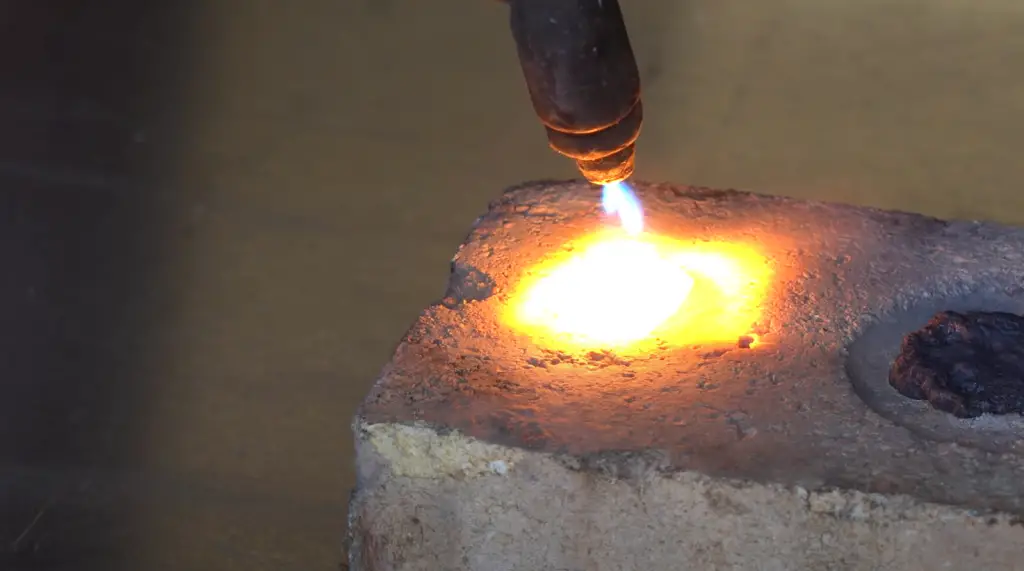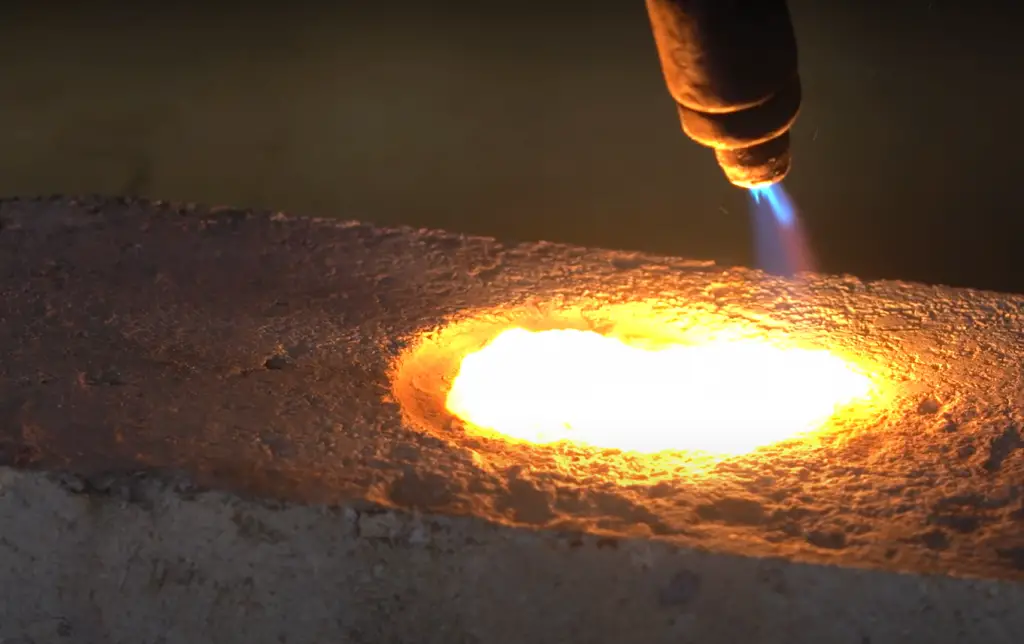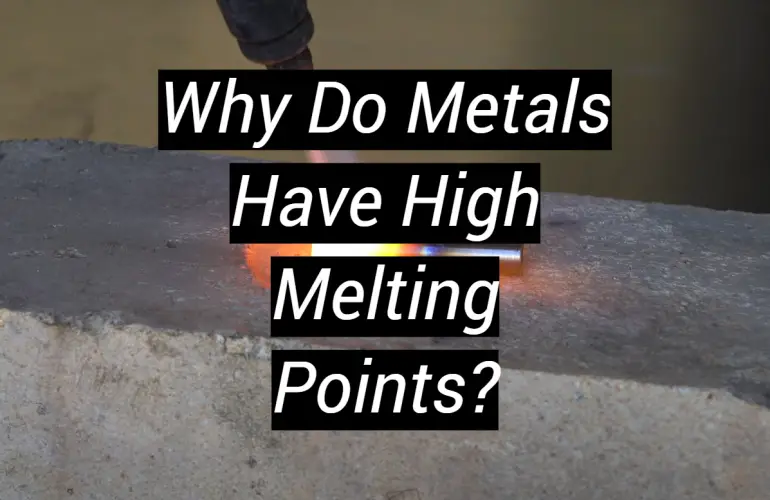Why Do Metals Have High Melting Points?
One of the intriguing properties of metals is their high melting points. How is it that metal can tolerate such extreme temperatures before melting? In this blog post, we’ll explore the answer to this question and uncover some of the science behind why metals have such high melting points. So read on to learn more about this fascinating topic!
What Does High Melting Point Mean?
Metals are distinguished by their remarkably high melting points, the temperature at which a solid transforms into a liquid. The heat energy required to reach this point is called the heat of fusion. Generally speaking, metals have higher melting points than non-metallic solids because of their unique atomic structure. Metals, as opposed to polymers and ceramics, are held together by tremendously strong metallic bonds. It takes considerable heat energy for the atoms in metals to break apart due to their remarkable binding strength. As such, it takes much greater amounts of heat energy for metal molecules to be separated and transition from a solid state into liquid form.

Various factors impact the melting point of a metal, including its crystalline structure, atomic weight, and bonding type. Metals with a higher atomic weight and/or multiple crystalline structures often have higher melting points than those with lower weights or fewer crystalline formations.
Additionally, metals with different types of bonding can have varying melting points as well. For example, covalent bonds, which involve atoms sharing electrons, can create stronger metal structures than ionic bonds that occur when oppositely charged particles are attracted to each other. As such, covalently bonded metals may require more energy and heat to melt compared to those held together by ionic forces.
Metals’ high melting points make them ideal for many applications where strength and durability are needed in extreme conditions, such as construction work or industrial processes. The ability of metal materials to withstand extreme temperatures and pressures makes them invaluable in a wide variety of applications. [1]
Why Do Metals Have Higher Melting Points Than Nonmetals?
The answer lies in the structure of metals. They have strong metallic bonds that involve sharing electrons between metal atoms, giving them a lattice-like structure similar to a solid. This makes it difficult for their atoms to break apart and enter their liquid phase, resulting in higher melting points than nonmetals.
Metals also tend to have more densely packed structures than nonmetals, meaning that they must absorb more energy before the atomic bonds can be broken and the material melts. The amount of energy needed increases as the atomic number of an element increases, which is why elements with higher atomic numbers generally have higher melting points than those with lower atomic numbers. This can help explain why metals tend to have such high melting points compared to nonmetals.
In addition, metals are often found as alloys, which can also contribute to their high melting points. Alloys are materials made from combining two or more elements, and they usually have a higher melting point than either of the individual components. This is because the two or more elements combine to form stronger bonds between them than would be present if the same elements were in their pure forms. This gives alloys an additional layer of resistance against melting, making them even harder for heat energy to break apart and enter their liquid phase.

The combination of strong metallic bonds, densely packed atomic structures and alloy compositions give metals higher melting points than nonmetals. For example, aluminum (Al) has a melting point of 660°C, while sulfur (S) has a melting point of just 113°C. This difference in melting points is due to the unique properties that metals possess, and it’s why they tend to have such high melting points compared to nonmetals. [2]
Why Does The Melting Point Of Metals Vary?
The melting point of metals varies depending on their chemical composition and structure. Metals are composed of a lattice of atoms held together by metallic bonds. The bonds between metals are strong and require a great deal of energy to break, which is why they have such high melting points. For instance, pure iron melts at 1535°C (2795°F).
The presence of other metal elements in alloy steel makes the metallic bonds stronger and thus increases the metal’s overall melting point. Additionally, some metals also contain impurities or dopants which also contribute to the melting point. Non-metal elements such as oxygen, sulfur and nitrogen can form stronger metallic bonds that are harder to break apart than those from pure metals, thus increasing the melting point.
Not only does the type of metal affect its melting point, but also the structure in which it is formed. Metals with a face-centered cubic crystal structure are typically more heat resistant than metals that have body-centered cubic structures, and therefore they tend to possess higher melting points. This is because it takes more energy to break apart the atoms in face-centered cubic crystals due to their relative close packing compared to molecules in body-centered cube crystals. [3]
Why Do Metals Have High Boiling Points?
Metals have high boiling points due to the strong metallic bonds that hold atoms together within them. These strong bonds are formed as a result of metal atoms giving up electrons in order to form a lattice-like structure, known as a metallic bond. The additional number of electrons held by each metal atom makes it more difficult for the atoms to move away from each other when heated, resulting in higher boiling points for metals compared to non-metals.
Additionally, because metal atoms are all nearly identical in size and shape, they can pack closely together, which also contributes to the material’s high boiling point.
In general, larger metal atoms will have higher boiling points than smaller ones. This is because larger metal ions require more energy for the electrons to break away from them. As a result, the boiling point increases with the size of the metal atom.

Because of their strong bonds and close packing, metals have much higher boiling points than other substances like water, which has a low boiling point of 100 degrees Celsius. In fact, some metals have boiling points that exceed 2000 degrees Celsius!
What Is The Difference Between Metals And Metalloids?
Metals and metalloids are the two main types of elements on the periodic table.
Metalloids have some of these properties but not to the same extent as metals. This is why they have lower melting points than metals; their condensed bonds are weaker than those found in metallic elements. The different electron configurations between metals and metalloids lead to differences in ionization potentials, which is also a factor influencing melting points.Generally speaking, the higher an element’s ionization potential is, the higher its melting point will be due to increased attraction forces within its atomic structure.
Each metal has unique physical characteristics that contribute to its melting point, such as the amount of force required to overcome the metallic bonds and the number of electrons that are shared among its atoms.
Van der Waals Forces, or weak intermolecular forces, can also play a role in an element’s melting temperature; these forces are stronger in large molecules and thus affect larger elements more than smaller ones.Finally, metals tend to form alloys with some other elements which can increase their overall melting point. Alloys usually contain two or more metals combined together which makes them harder and able to withstand higher temperatures before melting.
In summary, metals have higher melting points than metalloids due to their stronger electron configurations, larger atomic sizes and the presence of van der Waals Forces. In addition, when metals form alloys with other elements, their melting point increases significantly as well. [4]
Do All Metals Have A High Melting Point?
No, not all metals have a high melting point. Some metals, such as lead and mercury, are relatively low-melting compared to other metals. Nonmetallic substances like carbon can also have a higher melting point than some metals. Generally, the more metallic elements that make up a metal, the higher its melting point will be. This is because of the strong bonds between atoms in these materials. The stronger the bond between atoms, the more energy it takes to break them apart or melt them down.
Does Higher Melting Point Mean Stronger?
Metals have high melting points because of their strong metallic bonds. The strong metallic bond is caused by the electrostatic attraction between the positively charged metal ions and the negatively charged surrounding electrons. This type of bond creates a strong force that makes it difficult to separate the metal atoms from each other.
As a result, metals require more energy to break these bonds compared to other materials with weaker bonds such as polymers or ceramics. While higher melting points do indicate stronger forces within a material, they don’t necessarily mean that the material is stronger overall.

In fact, some materials with very high melting points may be quite weak when subjected to other types of stresses such as mechanical force. Therefore, while higher melting points can be an indication of strength, it is not a reliable measure for determining the overall strength of a material. [5]
Do Nonmetals Have High Boiling Points?
Nonmetals generally have lower melting and boiling points compared to metals. Nonmetals are more likely to exist as gasses or liquids at room temperature, rather than solids like metals. This is because nonmetals typically have weaker Van der Waals forces between atoms, which makes it harder for them to stick together and form solid structures. Therefore, most nonmetals have much lower melting and boiling points than metals.
However, some nonmetallic substances can still have relatively high melting or boiling points due to their molecular structure or chemical properties. Carbon is an example of a nonmetal that has a very high melting point (3500°C). Similarly, certain types of hydrogen-bonded molecules such as water and ammonia also have relatively high melting and boiling points.
In general, the melting and boiling points of nonmetals are lower than those of metals because their structures tend to be less rigid and more easily disrupted when exposed to high temperatures. This makes them easier to liquefy or vaporize at lower temperatures compared to metals. In contrast, metals have strong Van der Waals forces between atoms which make them more resistant to disruption and hence they usually have higher melting and boiling points. [6]
FAQ
Why do metals have a high melting point GCSE?
Metals have high melting points due to the strong bonds between their atoms. These strong interatomic bonds form a lattice-like structure that is difficult to break down, requiring a large amount of energy in order to do so. This makes it difficult to change the metal’s state from solid to liquid at room temperature and pressure, resulting in a high melting point. In addition, metals often have an ionic or covalent bonding which increases the strength of these interatomic bonds even further. As such, metals can only be melted when heated beyond very high temperatures, typically ranging from 1200°C – 1600°C depending on the metal.
What would cause a higher melting point?
Metals have high melting points because of their strong metallic bonds. These bonds are made up of atoms that share electrons with each other and form a lattice structure. This creates a stable environment in which the atoms can no longer move around freely, thus increasing the amount of energy needed to break them apart.

Additionally, the more tightly packed arrangement of metal atoms leads to higher melting points than those seen in non-metallic substances. As metals heat up, these strong metallic bonds will eventually be overcome by thermal energy, causing them to melt. The higher the temperature of the substance, the more energy is necessary to break down these bonds and cause it to melt. Therefore, metals generally require extremely high temperatures before they can achieve their melting point.
Do all metals have a high melting point?
No, not all metals have high melting points. In fact, some metals have very low melting points. For example, mercury has a melting point of -38 degrees Celsius, while gallium has a melting point of 29 degrees Celsius. These metals have much weaker metallic bonds than other metals, such as iron or copper. As a result, they require less energy to break down and can achieve their melting point at lower temperatures.
What are some applications that require metals with high melting points?
There are many applications that require metals with high melting points. For example, metal alloys such as steel are often used in construction because of their strength and resistance to heat. Additionally, refractory metals such as tungsten are often used in applications where high temperatures are present, such as aerospace and automotive industries. Furthermore, metals with a higher melting point can be used to contain hazardous materials that require containment at very high temperatures, such as radioactive material. Finally, certain alloys of gold and platinum are often used for jewelry because these materials have relatively high melting points compared to other metals.
What does the melting point of metals depend on?
The melting point of metals depends on several factors, such as the type of metal and its crystalline structure. Metals are made up of densely packed atoms, which form strong bonds between each other called metallic bonding. This bonding is what gives metals their high melting points. Furthermore, metals have relatively small interatomic distances between their atoms – this means that more energy is required to break the bonds in order for them to melt. Additionally, some metals have multiple forms with different arrangements of atoms – this can also affect their melting points.
What does melting point tell you?
The melting point of a metal tells us how stable it is at certain temperatures. Metals with higher melting points are more stable and will be able to maintain their solid form even when exposed to high temperatures. This makes them useful for a variety of applications, including those in high-temperature environments such as aerospace engineering or medical implants. In conclusion, metals have high melting points due to their strong metallic bonding, small interatomic distances and multiple crystal forms which can all contribute to their stability at higher temperatures. Understanding the different factors that influence the melting point of metals is essential for developing safe and effective materials that can withstand extreme conditions.
Does a low melting point mean it melts faster?
No, the melting point of a metal does not necessarily indicate how fast it will melt.

Factors such as the size and shape of the metal can influence how quickly it melts. For example, metals with larger surface areas exposed to heat will usually melt at faster rates than those with smaller surfaces. Additionally, some metals may have lower melting points but require more energy in order to break their bonds and begin melting – this means that they may take longer to actually reach their melting point.
Useful Video: GCSE Chemistry 1-9: Why do Ionic Compounds have High Melting Points?
Conclusion
Metals have high melting points due to their metallic bonding structure. In this type of bond, valence electrons are free to move around in the solid material, and many atoms interact with each other through powerful electrostatic forces. These strong forces create strong intermolecular bonds that require a lot of energy to break apart. This is why metals are able to maintain a higher temperature before they start to melt than molecules composed of weaker covalent or ionic bonds. This property makes metals ideal for use in construction, as well as other applications where heat resistance is necessary. Without their high melting point, many modern inventions wouldn’t be possible.
Therefore it is clear that understanding why metals have such high melting points can be an important part of understanding the properties and uses of metals. In summary, metals have high melting points due to their metallic bonding structure which is formed by strong electrostatic forces between atoms that require a lot of energy to break apart. This property makes them ideal for use in applications where heat resistance is needed.
This concludes our discussion on why metals have high melting points. We hope you now understand the concept better, and can apply this knowledge in future studies or analyses involving metal materials.
Thank you for reading!
References:
- https://www.bbc.co.uk/bitesize/guides/z84tjty/revision/2
- https://www.mytutor.co.uk/answers/55663/GCSE/Chemistry/Why-do-metals-have-high-melting-points/
- https://www.vedantu.com/question-answer/metals-often-have-high-melting-and-boiling-class-11-chemistry-cbse-611ea97901d8df2a7d94ad85
- https://www.nagwa.com/en/videos/516163592413/
- https://chem.libretexts.org/Bookshelves/
- https://homework.study.com/explanation/do-nonmetals-have-high-or-low-boiling-points.html






